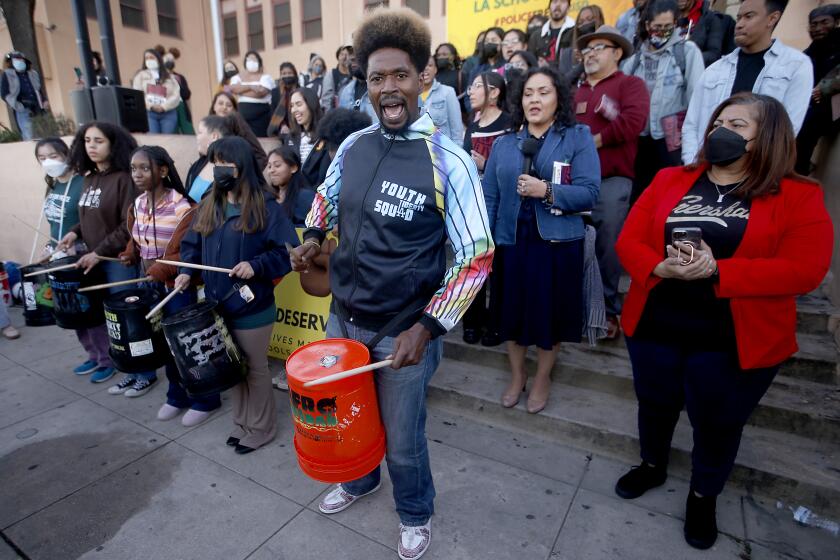Violence dropped at California middle and high schools over 18 years, UCLA study finds

- Share via
A UCLA study found steady and steep decreases in California school violence over 18 years, including fights and reports of guns and other weapons on campus, results that indicate students generally felt safe at school despite nationwide mass school shootings.
The report documented a 56% reduction in physical fights and a 70% reduction in reports of guns being carried onto school campuses while reports of other weapons, such as knives, fell by nearly 70%. Victimization reported by Black and Latino students, which includes instances of being bullied or assaulted, saw larger declines than victimization reported by white students.
The study by UCLA’s Luskin School of Public Affairs analyzed data from 2001 through 2019 in the confidential California Healthy Kids Survey. Published late last month in the World Journal of Pediatrics, the survey took in 6.2 million seventh-, ninth- and 11th-graders from more than 3,200 public schools.
State officials have released preliminary floodoing forecast for the San Joaquin Valley and Tulare Lake Basin due to a historic snowpack.
“These findings were evident in more than 95% of California schools, in every county, and not in wealthy suburban schools only,” said Ron Avi Astor, a co-author of the study and professor of social welfare and education at the Luskin School and the UCLA School of Education and Information Studies.
The other co-authors were Rami Benbenishty of the Hebrew University of Jerusalem and Universidad Andrés Bello in Santiago, Chile, and Ilan Roziner of the Sackler School of Medicine at Tel Aviv University.
In a statement, Astor said the study suggests that “gun violence should be treated as a separate social and psychological phenomenon.”
“Each school shooting is a devastating act that terrorizes the nation, and there is a growing sense in the public that little has changed in two decades to make schools safe,” Astor said in the statement. “But mass shootings are just one part of this story. Overall, on a day-to-day basis for most students, American schools are safer than they’ve been for many decades.”
He attributed the widespread decreases in school violence to a variety of factors, including a focus on improving campus climate in the wake of the Columbine High School shooting and other campus shootings in the late 1990s.
“[Billions] and billions of dollars, if you look at the state, national and local levels, have been invested in social-emotional programs ... and educating school staff on how to create more caring, welcoming settings,” Astor said in an interview with The Times.
Activists challenge L.A. Unified superintendent’s support of school police, as well as school board members who reduced the police budget but did not disband the agency.
Additionally, there was an a massive influx of social workers, counselors, psychologists and other “people personnel” on campuses, Astor said.
“If you look at where we were 20 years ago to now, in the [Los Angeles Unified School District], for example, there were a few, 100 maybe,” Astor said, adding the numbers have substantially increased.
“And you see that in district after district after district,” Astor said.
However, reports of discriminatory bullying held steady across the nearly two-decade study, Astor said.
And although the study ended in 2019, other data havr shown an uptick in discriminatory bullying in the wake of the COVID-19 pandemic, which leveled out this year, Astor said.
Mobile home parks are among the most affordable places to live in California. But oversight has left many residents at risk of living in horrible conditions.
That corresponds with a recent survey of California high school principals who noted increases in incidents of discrimination against LGBTQ, Black and Latino students.
“I think one of the reasons, in my mind, for that is we haven’t really worked on [discriminatory bullying] until recently,” Astor said. “I think this is an area we need to work on.”
Additionally, the specter of school shootings still haunts the generally positive data.
“I think there’s a deep sense of disillusion that every time there’s a shooting, there’s almost a feeling that we invested all this time and energy and nothing works, that our schools are getting worse,” Astor said.
But the data do not bear that out, with students themselves reporting that they are experiencing less day-to-day violence than before and feeling more connected and safer, Astor said.
“They’re also telling us in other surveys that they’re afraid of dying,” Astor said. “We have to figure that out, even though it’s complex.”
More to Read
Sign up for Essential California
The most important California stories and recommendations in your inbox every morning.
You may occasionally receive promotional content from the Los Angeles Times.














